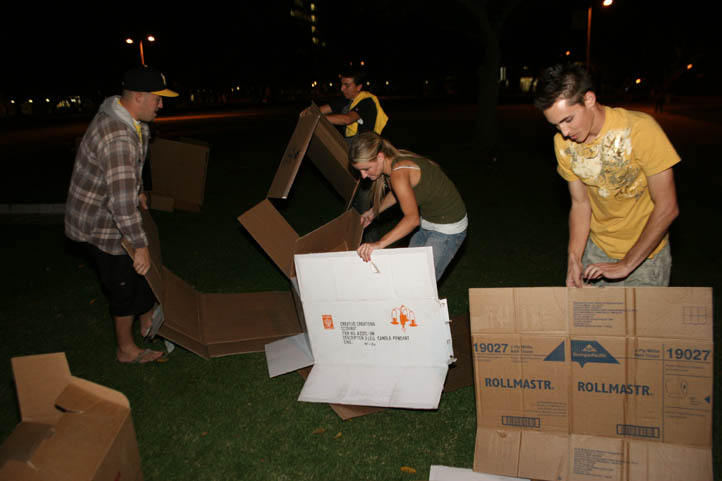While many students left for their comfortable homes as the sun set last Thursday, a group of students was just arriving to spend the night on the Commencement Lawn in impromptu cardboard shelters.
Associated Students, Inc. invited Cal State Long Beach students to participate in the second annual B.E.A.C.H. (Becoming Educated and Confronting Homelessness) sleep-out from Thursday to Friday on the Commencement Lawn on upper campus.
According to T.J. Huberg, a communication studies professor, about 75 percent of the country is two paychecks away from becoming homeless,
Prior to the sleep-out, Kimberly Helm, ASI community service commissioner and organizer of the event, spoke to three homeless people in an attempt to make the event as real as possible.
“There’s this idea of homeless people being less than average, like they’re not normal,” Helm said.
Roughly 25 students slept on the lawn and in shelters built out of cardboard.
The sight was that of a suburban Skid Row. Thick, wide, brown sheets of cardboard were strewn about the lawn, and the sound of tape ripping screeched in the air. One shelter looked like a coffin, while others were just sides of walls and a piece of cardboard for a mattress.
Jamie Simmons, an undeclared freshman, said, “[I] usually help out with the homeless, now [I] get to experience it.”
Peter Kang, a freshman electrical engineering major, and Brian Cha, a freshman aerospace major, built a fort-like haven complete with a peak roof and room dividers.
“I want to understand the complex mind of a homeless person,” Kang said.
Cha agreed, “I want to gain a different state of mind.”
Sherwin Parker, a senior education major, was among the participants.
“It’s an inconvenience, but I can go home after this,” he said.
Nearly 35,000 people are homeless in Long Beach, according to Huberg.
James Brown, a veteran, was homeless for 10 years after he lost his job. Brown started the Long Beach Community Action Network to help those without homes.
“I was just looking for a place to lay my head,” Brown said. He added that many homeless people range from ages 13 to 26.
“You will never notice that a kid is homeless, unless they want you to know,” Brown said. “Everybody knows somebody who is homeless. The worst thing is the community isolates them.”
Huberg herself went from having everything to nothing overnight.
“I went immediately into survival mode, I looked for puddles to get water,” Huberg said about the one year she spent homeless. “There’s a difference between eating pizza [from a box] and picking a half-eaten cheeseburger out of a dumpster.”
Basic things like bathrooms, shelter and clothing — things most people take for granted — are not easily available for the homeless. Both speakers stressed the loneliness within the homeless community and how little most know about resources that can help them.
There’s huge misconception about the homeless being panhandlers, drug addicts or alcoholics when many are just average citizens, they added.
Both Brown and Huberg’s message was clear: Don’t be afraid of the homeless and wanting to help them.
By 6 a.m. the next morning, the lawn was deserted.
“It was freezing!” marketing major Wendy Salas said of the sleep-out. “Cardboard and a blanket are definitely not enough. I know what [the homeless] go through and I couldn’t handle it for more than one night.”
“There’s this judgment of the homeless,” Huberg said. “Some [homeless] people want a smile or just to be talked to.”




